Cilantro is a phenomenal “must use” herb that brightens up the appearance and taste of any dish with its perky green color and lemony refreshing flavor. Although fresh cilantro is used as a garnish in many Indian dishes, it can be a game-changer when added to soups, salads, and meals. This delicate herb adds oodles of flavor to your food with its distinctive fragrance while throwing in a bunch of nutritional benefits too.
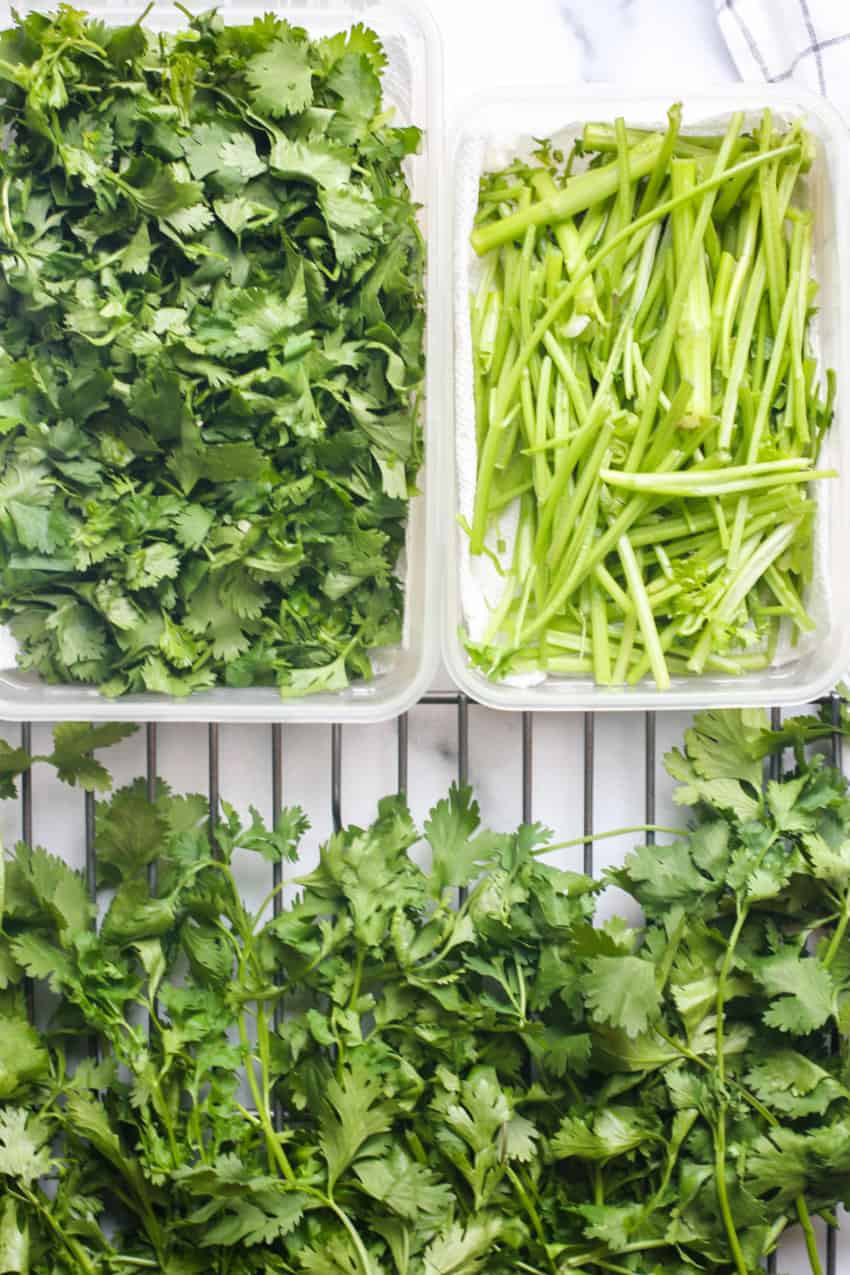
I use cilantro quite liberally in my cooking and it is a must-have in my refrigerator at all times. I cook a lot of Indian dishes that are either bright red or yellow, and I love how this bright green herb adds a beautiful contrast to my food. Topped with some freshly chopped cilantro leaves, these dishes take on a new avatar altogether. Dream!

Jump to:
Taste
If you are a cilantro lover like me, this will baffle you, but for some, cilantro tastes like soap! Cilantro contains a natural aldehyde chemical, similar to that found in soaps. Some people have a certain genetic trait because of which they perceive cilantro to be soapy. In reality, though, cilantro is not soapy to taste but in fact mildly pungent and citrusy.
Benefits
In addition to great flavor, cilantro comes packed with vitamin C and provitamin A & K. Cilantro has antioxidant and anti-inflammatory properties making it a healthy herb. Research suggests that cilantro may help to reduce the risk of heart disease & diabetes while promoting healthy skin and hair.

Prep & Store
Fresh cilantro has high water content and if not stored properly can quickly go bad. Over the years, I would put the cilantro standing upright on the side door of my refrigerator in a produce bag. This method is quick and the cilantro will easily last for a week.
If you can spend a little more time prepping the fresh cilantro it is easy to have the freshest cilantro by extending its shelf life for up to 3 weeks. There are a couple of methods I have tried and tested for prepping and storing cilantro.
First, rinse cilantro really well under cold running water 2 to 3 times or until it is free of grit.
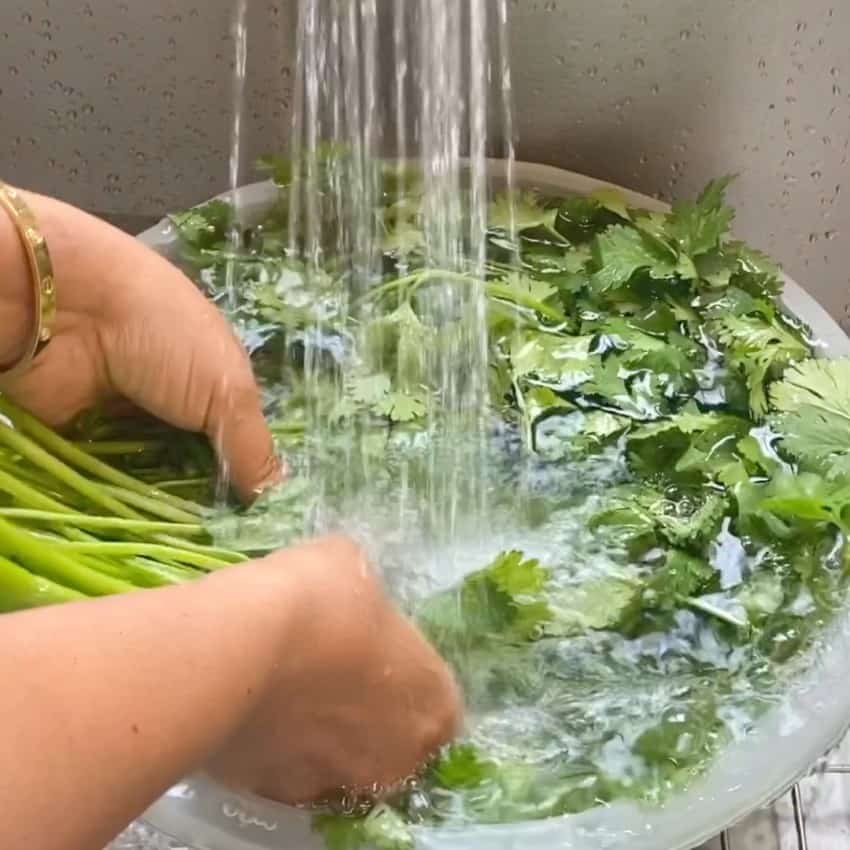
Then, place the cilantro in a strainer and drain most of the water out. You can also gently shake off the leaves to help remove excess water.
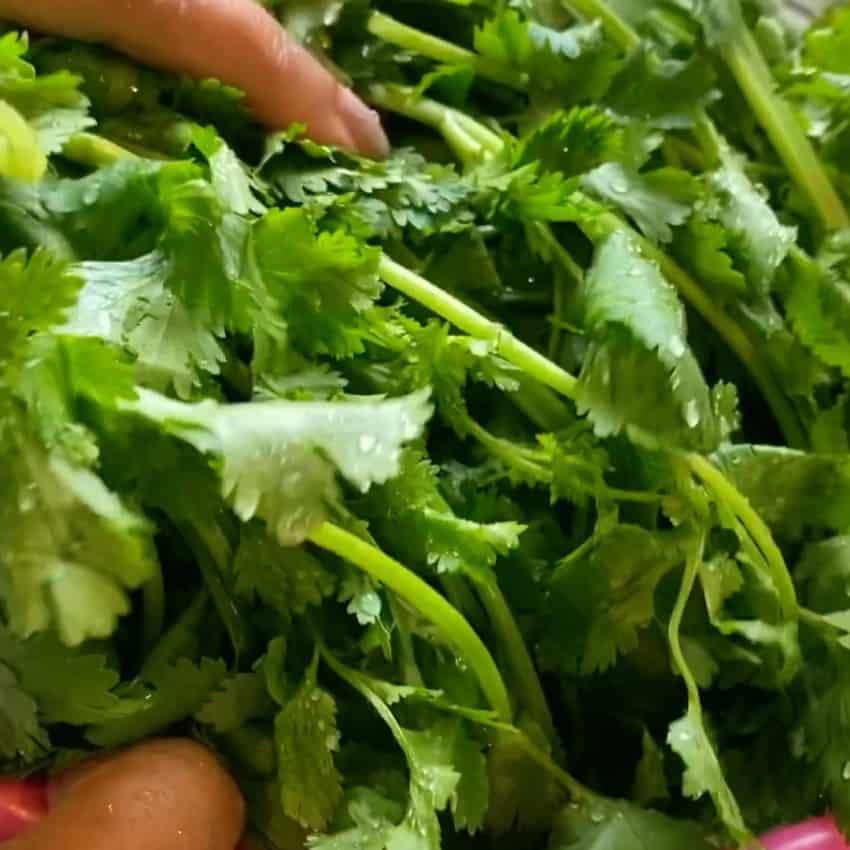
Next, picking up individual plants by their stems, spread them on kitchen towels. Take as much space as you need making sure they are not overlapping too much.
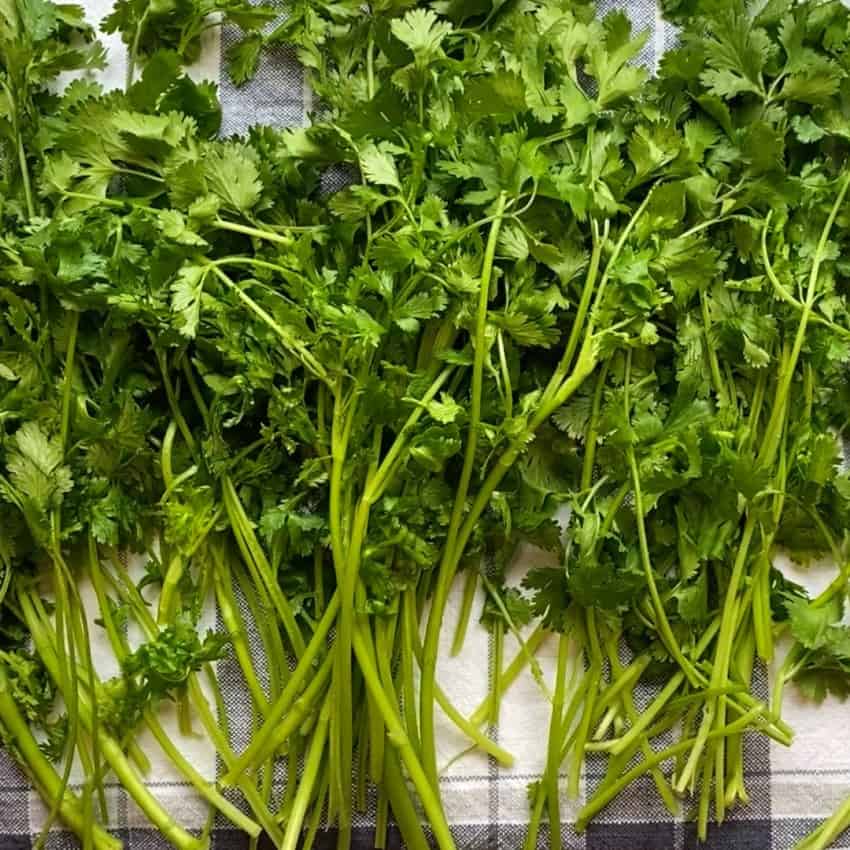
During this process pick out any yellow or brown leaves and discard them.
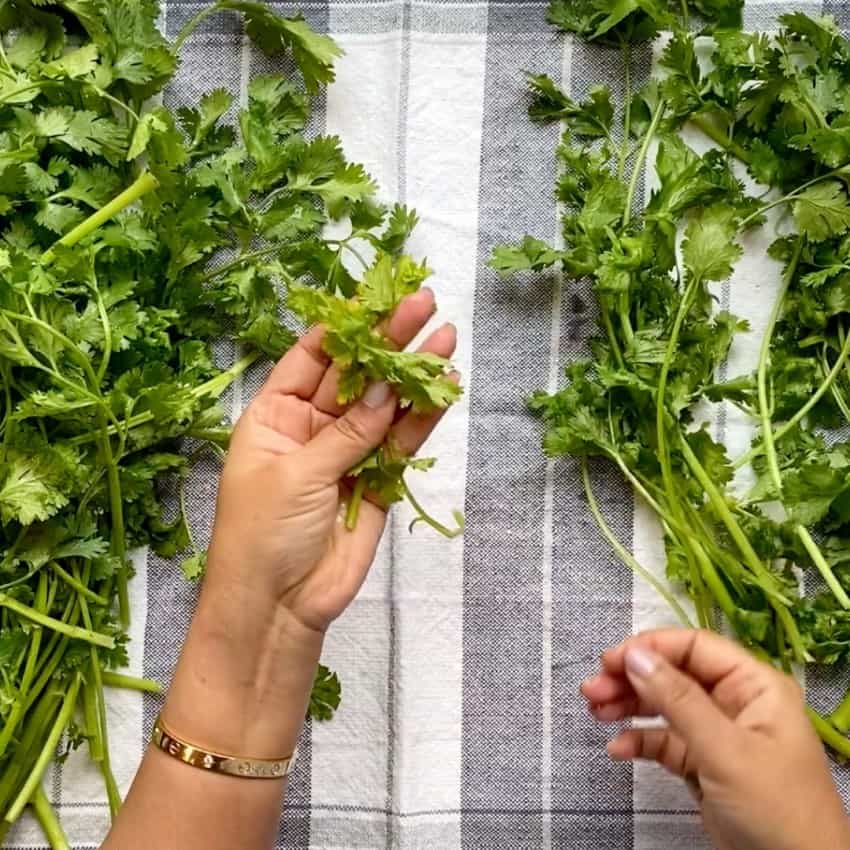
Pat dry excess moisture with paper towels. At this point you have 2 options to store the cilantro:
Option 1 - Refrigerated in a glass of water
Trim the bottom stems of cilantro. Do not discard the stems, freeze for extended shelf life or keep refrigerated in an airtight container lined with paper towels. These stems can be used to make chutneys, soups, or broths.
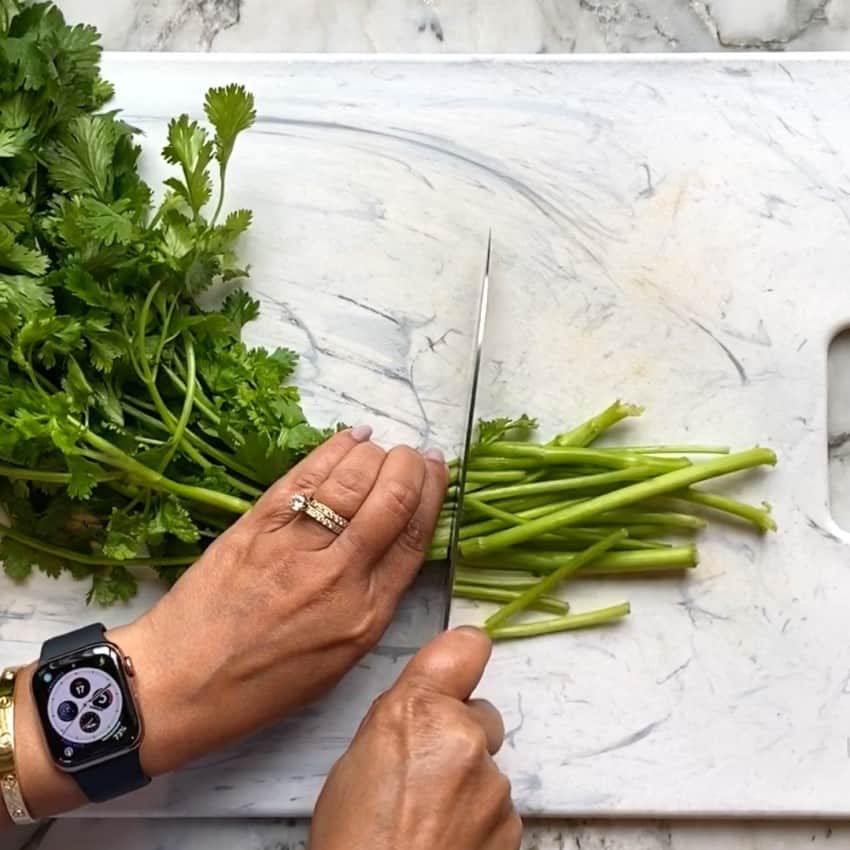
Place the cilantro leaves upright in a cup filled with cold water.
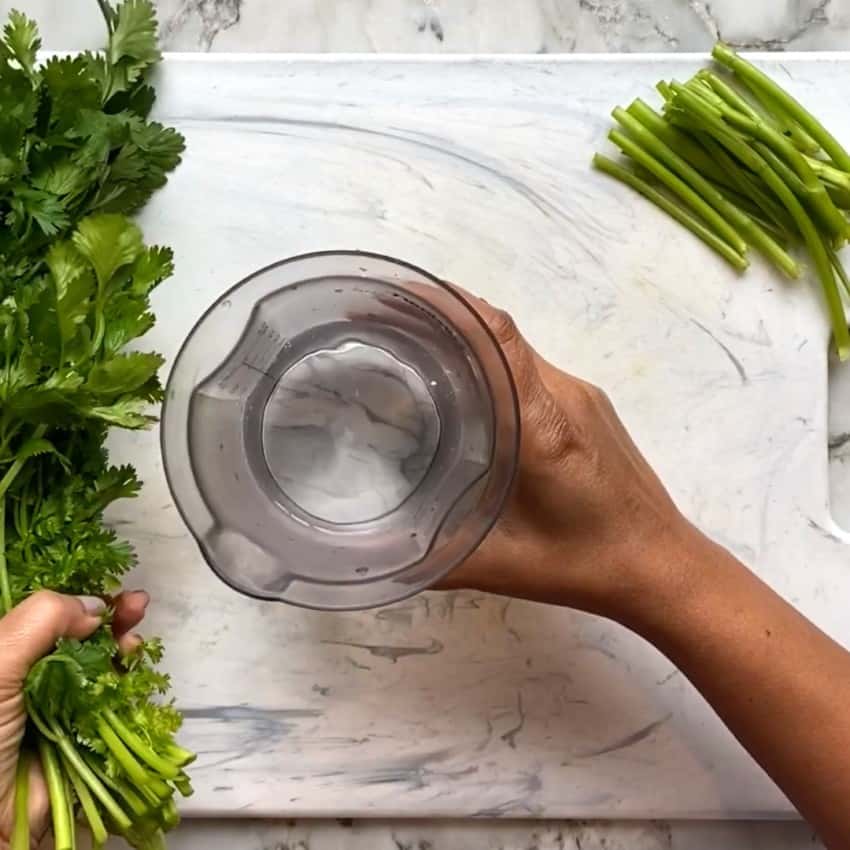
Next, cover the leaves with a clear plastic produce bag and secure with a rubber band or tie a knot with the produce bag
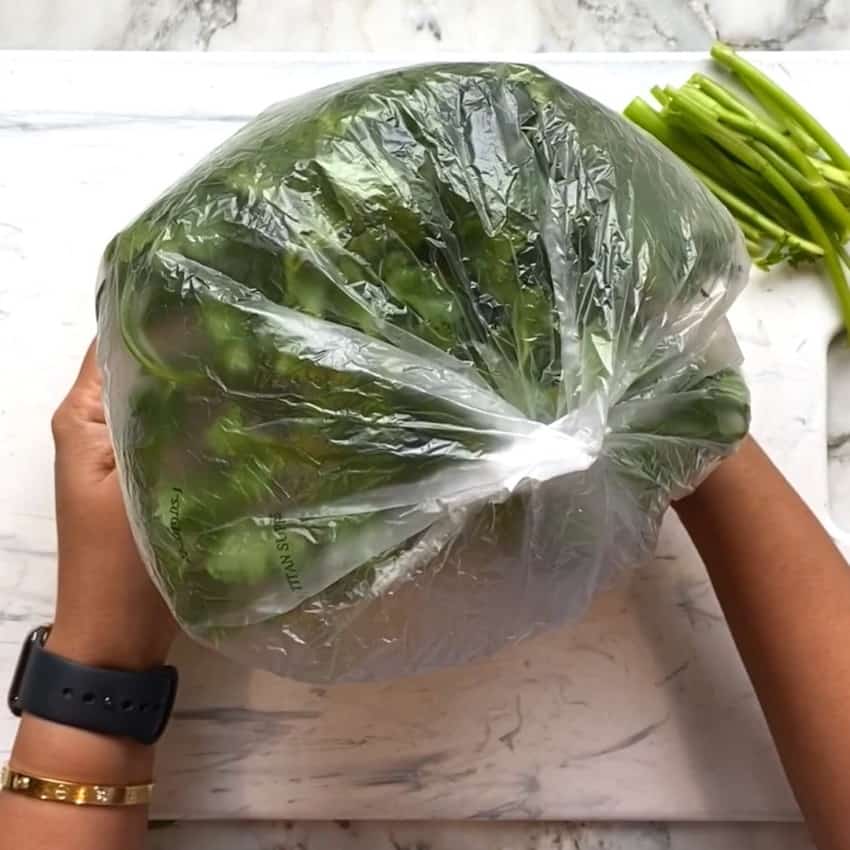
Keep the cup in the refrigerator door and check every 4-5 days. Change the water as needed. This method will ensure that your herb stays fresh for 2-3 weeks.
Option 2 - Chop and refrigerate
This works great if you use cilantro in your everyday cooking as the chopped cilantro is convenient to use and lasts for weeks.
Clean and spread the cilantro on kitchen towels. Leave out to dry for 2-3 hours till all the water has completely dried off. Cut the stems and freeze for extended shelf life or keep refrigerated in an airtight container lined with paper towels. These stems can be used to make chutneys, soups, or broths.
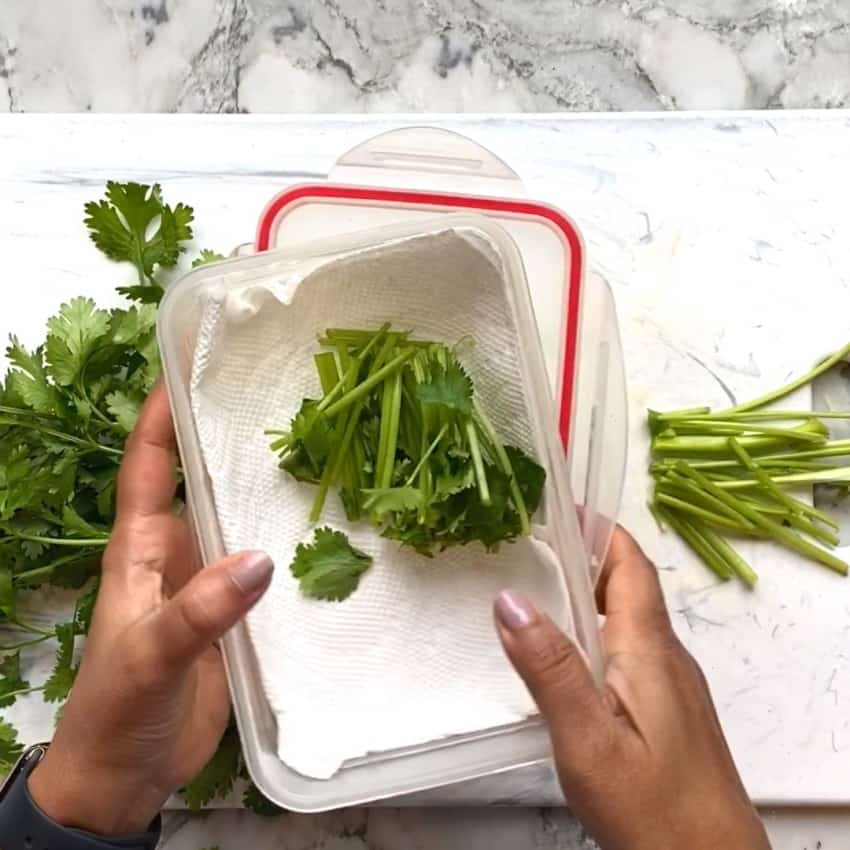
Coarsely chop the leaves. Note: Make sure the cilantro has no moisture and it should not stick to your hands while chopping.
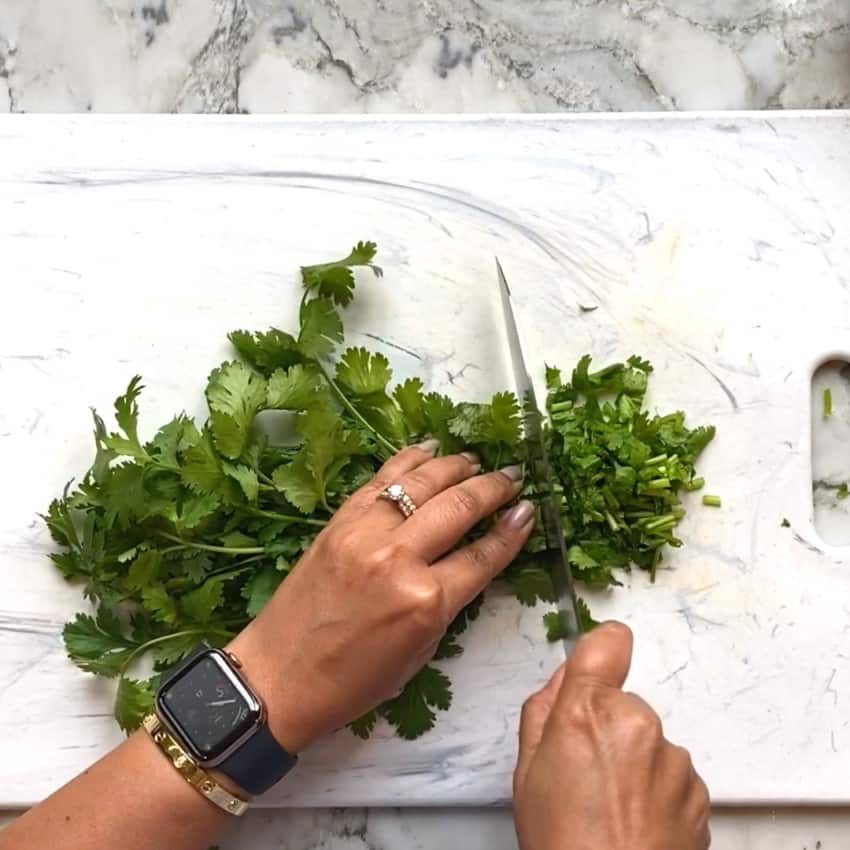
Loosely Place the leaves in a paper towel lines container.
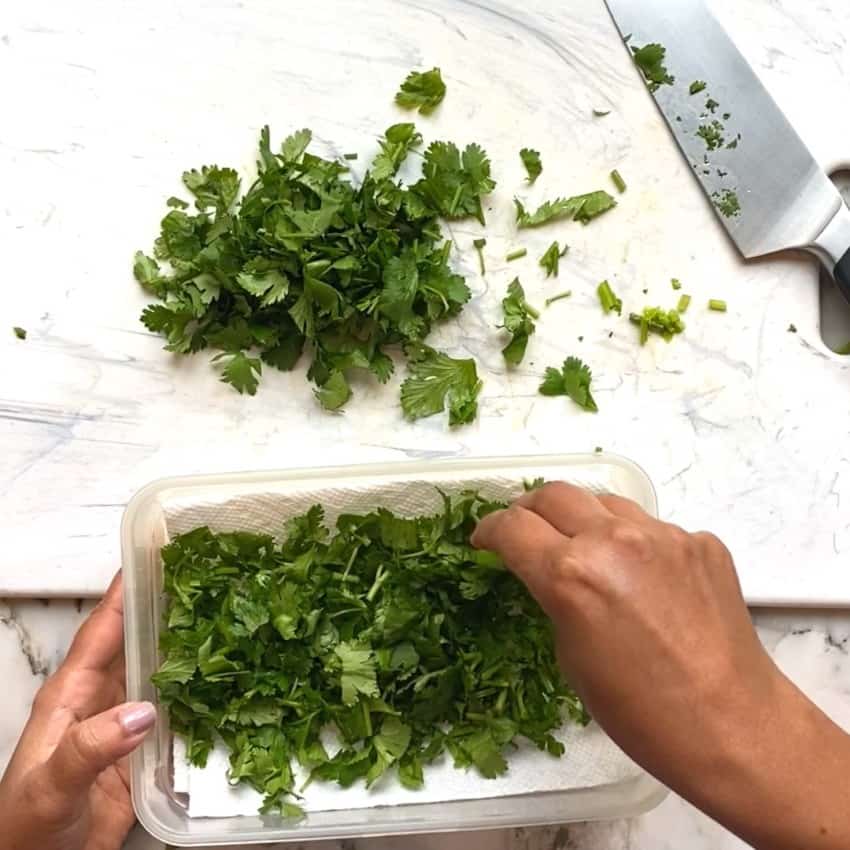
Cover with another paper towel.
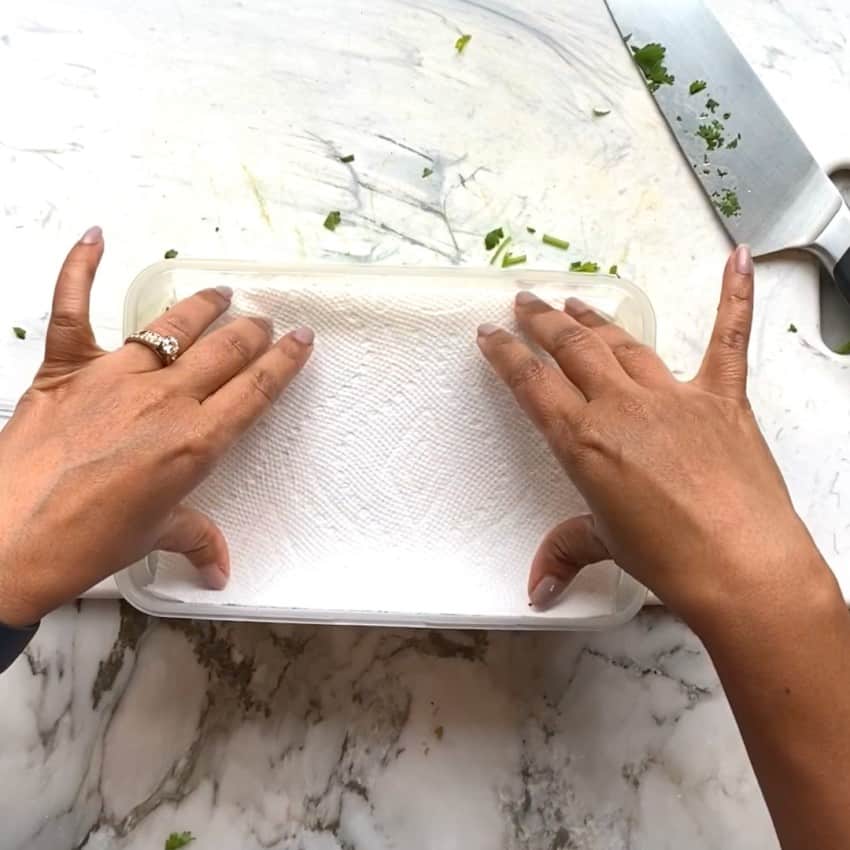
Check every 4-5 days and discard yellow/brown leaves if any.
Pro Tip: Does your refrigerated cilantro look wilted? Put it in ice-cold water for 5 minutes and see it magically crisp up and look as fresh as the day it was bought.
Option 3 - Using a raw egg
This is the latest cilantro storing idea I shared on Instagram:
- Pick out any browned, yellow leaves from the bunch and discard them.
- Pat dry the cilantro with paper towels, no need to wash it. Loosely keep the cilantro in an airtight container or a herb storage container with a raw egg. The porous shell of the egg helps absorb excess moisture keeping the cilantro fresh for 4 to 6 weeks.
- Make sure to keep checking every week and picking out any yellow/brown leaves. Also, make sure to disard the egg if you haven't used up the cilantro in a couple of weeks.

Option 4 - Air Drying
Here is the last option that I learned from my friend Karen Lee. Karen suggests air-drying cilantro so that it can be stored for months.
Although Indian cooking usually calls for fresh cilantro, I thought having air-dried cilantro is also a good option for when you have completely run out of cilantro and cannot go to the store.
Here is Karen's process for air drying which I tried out and worked great. So this summer when cilantro will be available abundantly I may air dry some extra to use later.
Place a cooling rack on top of a kitchen towel. Trim the thicker stems of the cilantro and line the cilantro on the rack.
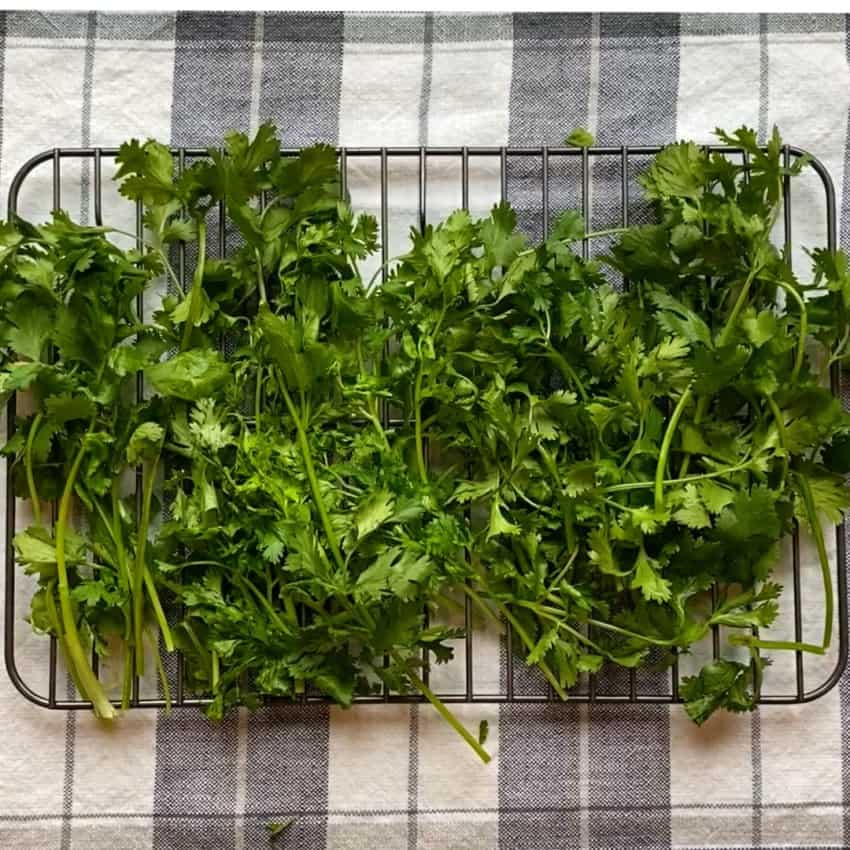
Allow to air dry for 5 days or until the leaves and the stems are completely dry.
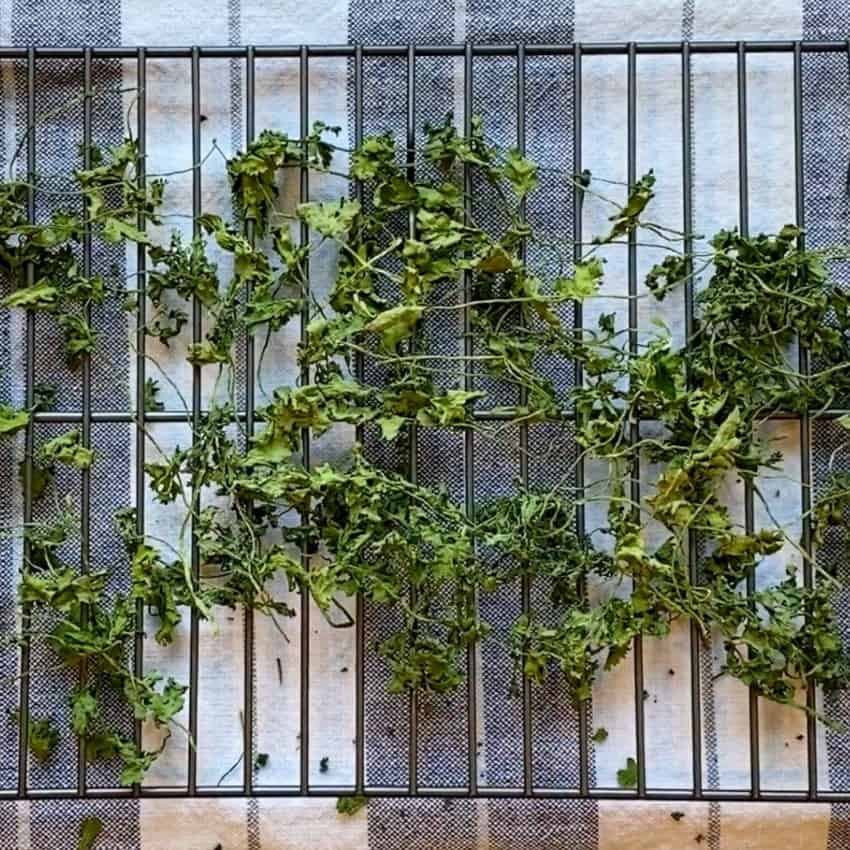
Place the dried cilantro in an airtight jar. (Note: the photo below is in a bowl to show the texture)
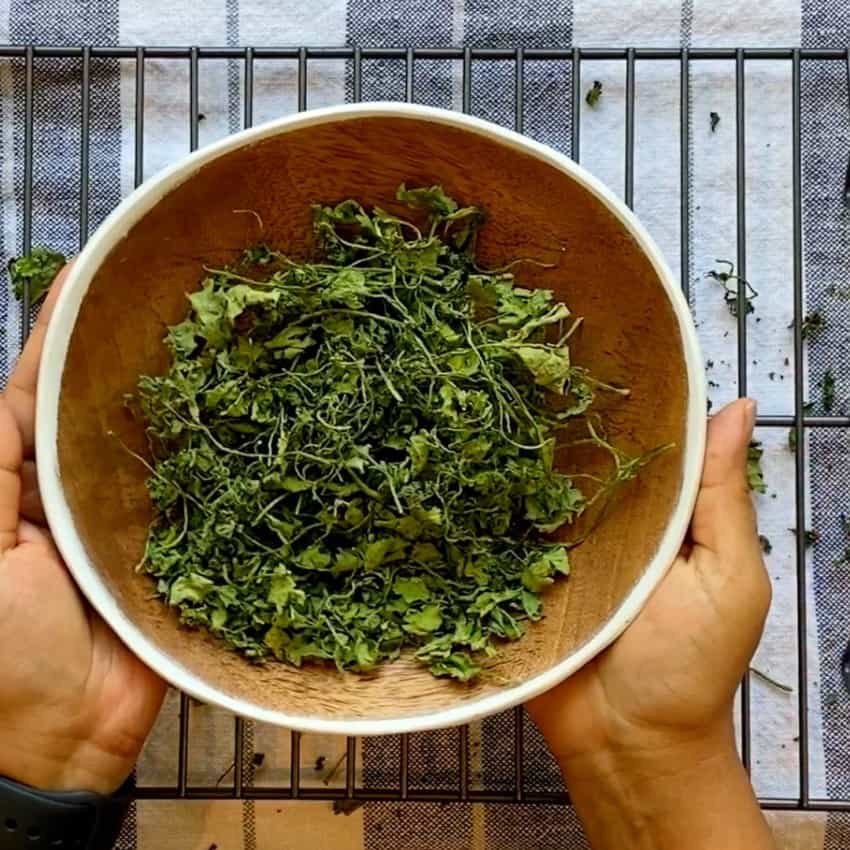
Recipes
Cilantro is awesome for garnishing, and it is also used as a star ingredient in many recipes. Here are a few of our favorites:
- Instant pot chicken cilantro soup
- Instant pot kothimbir vadi
- Salmon tikka masala skewers
- Baked salmon with fresh herb chutney
- Spicy mango salad topped with fresh cilantro
Did you find this post useful? Check out these cooking101 articles that will help you with meal prepping and also save time.
Do you eat cilantro stems
All parts of this herb are edible and you can totally eat the stems. The cilantro stems are usually tender and even more flavorful than the leaves. Use them in soups or to make chutneys and see how flavorsome your dish will be.
Are cilantro and coriander same
Absolutely, they are! Cilantro is an annual herb reaped from the Coriandrum Sativum plant. Cilantro is a Spanish name for coriander, as it is referred to in India. It is also known as Chinese parsley in parts of Asia. In India, cilantro is also popularly known as kothimbir or dhaniya. All parts of the plant, including the seeds (coriander seeds) are edible, and are used to flavor different cuisines across the world.
Where can you buy cilantro
Cilantro is very easily available in the fresh herbs section at most grocery stores. I usually pick mine at my local Farmers Market as they always stock big, fresh, healthy bunches of this herb.
★ Have you tried this recipe? We love your feedback, Please click on the stars in the recipe card below to rate.
How to prep & store fresh cilantro
Equipment
Ingredients
- fresh cilantro
Instructions
- Cilantro has high water content and if not stored properly can quickly go bad. If you do not have time, here is the quickest method that will keep your cilantro fresh for at least a week. Pick out any browned, yellow leaves from the bunch and discard. Wrap the herb in paper towel, put it in a produce bag, and store it upright in the door compartment of the fridge
- If you can spend a little more time prepping the cilantro it is easy to have freshest cilantro by extending its shelf life for up to 3 weeks. There are a couple of methods I have tried and tested for prepping and storing cilantro. First, if your cilantro bunch has roots, chop them off and discard. Pick out any browned or wilted cilantro and discard
- Then rinse the cilantro really well under cold running water 2 to 3 times or until it is free of grit
- Place the cilantro in a strainer and drain most of the water out. You can also gently shake off the leaves to help remove excess water
- Next, picking up individual plants by their stems, spread them on kitchen towels. Take as much space as you need making sure they are not overlapping too much
- During this process pick out any yellow or brown leaves and discard them
- Pat dry excess moisture with paper towels. At this point you have 2 options to store the cilantro:
- Option 1 is to keep refrigerated in a glass of water using following steps:
- Trim the bottom stems of cilantro
- Place the dry cilantro leaves upright in a cup filled with cold water
- Next, cover the leaves with a clear plastic produce bag and secure with a rubber band or knot the ends of the bag togther
- Keep the cup in the refrigerator door and check every 4-5 days. Change the water as needed. This method will ensure that your herb stays fresh for 2-3 weeks
- Option 2 is to chop the cilantro leaves and refrigerate
- This works great if you use cilantro in your every day cooking as the chopped cilantro is super convenient to use and lasts for weeks
- Clean and spread the cilantro on kitchen towels. Leave out to dry for 1 - 3 hours or untill all the water has completely dried off. Cut the stems and freeze for extended shelf life or keep refrigerated in an airtight container lined with paper towels. These stems can be used to make chutneys, soups or broths
- Next, coarsely chop the leaves. Note: Make sure the cilantro has no moisture and they should not stick to your hands while chopping
- Loosely place the chopped leaves in a paper towel lined container. Cover with another paper towel and refrigerate
Option 3 using a raw egg
- This is the latest cilantro storing idea I learnt from my foodie friends over on Instagram. Pick out any browned, yellow leaves from the bunch and discard. Pat dry the cilantro with paper towels, no need to wash. Loosely keep the cilantro in an airtight container or a herb storage container with a raw egg. The porus shell of egg helps absorb excess moisture keeping the cilantro fresh for 4 to 6 weeks. Make sure to keep checking every week and picking out any yellow/brown leaves. Also make sure to disard the eggs after you have used up the cilantro.
Video
Notes
- Make sure to dry the cilantro really well so that all of the excess moisture from cilantro is dried off. This is a key step to prevent your cilantro from going bad
- Do not discard the stems, freeze for extended shelf life or keep refrigerated in an airtight container lined with paper towels. These stems can be used to make chutneys, soups or broths
- Check every 4-5 days, pick our and discard any yellow or brown leaves
- Does your refrigerated cilantro look wilted? Put it in ice cold water for 5 minutes and see it magically crisp up and look as fresh as the day it was bought
- Place a cooling rack on top of a kitchen towel. Trim the thicker stems of the cilantro and line the cilantro on the rack
- Air dry for 5 days or until the leaves and the stems are completely dry and crisp
- Place the dried cilantro in an airtight jar
♥ Subscribe to our Youtube Channel for tasty and easy video recipes. Looking for more Instant Pot recipes? Check out our delicious Instant Pot Recipe board on Pinterest.



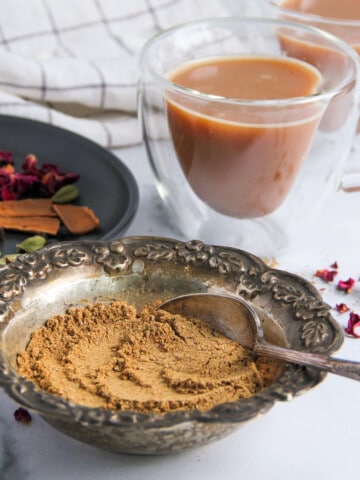
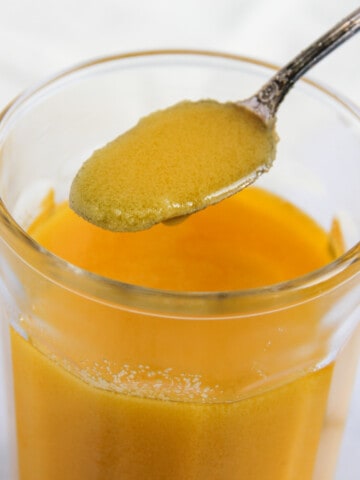
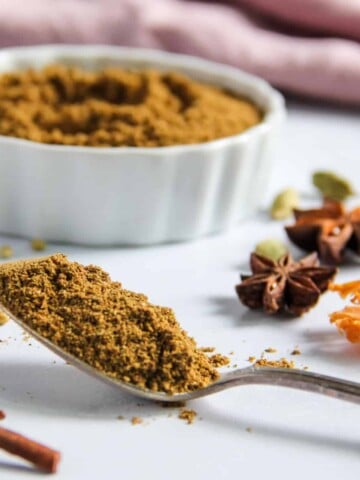
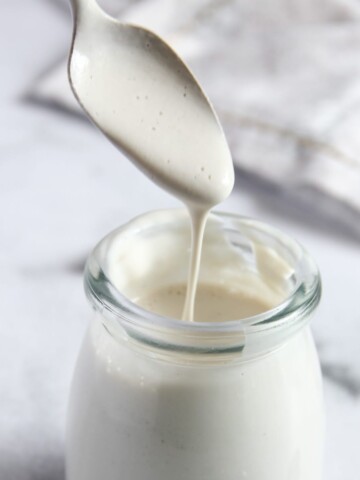
Judith Wahl says
THANK YOU THANK YOU THANK YOU for this posting, This is very helpful information . I have always had problems with Cilantro going bad before I used it up and this tells me what to do, I assume that I can use a food drier machine to dry the cilantro as well as use the method you describe for drying . If that's not a good idea please tell me. I have been getting groceries delivered and this time when I ordered ginger I received a massive amount instaed of the small piece which I usually break off in the store to then use . So this also gave me the info of how to store it . And the chili info too was perfect as now Ill order any chilis in a larger quanatity and then do what you instructed . I also love your recipes which I have been turning to more and more since I discovered your website. So you have made this older Polish Canadian avery happy consumer of homemade Indian food. I cant thank you enough.
Frank says
I have a method that works for. Cilantro and parsley and also soft fruits like strawberries, blackberries, blueberries to make them last much longer. And its some too. After washing the fruit or herbs place then in a container with some white vinegar and water, just enough vinegar to to smell mildly vinegary. After a few mintues remove and dry like your usual way, DO NOT RINSE! You will not taste or smell the vinegar later. And like above place paper towels to absorb any free water.
You will find that you can easily double the life or more of anything you gave the vinegar bath to. Supposedly the mild acid in the vinegar suppresses fungi and bacteria.
Steff says
Thanks so much! I will definitely try out all methods. Here in France the bunches of coriander are quite huge, and the much I love cilantro, most of the time its impossible to use it all up before it wilts. So again, thanks a lot!
Archana says
You are most welcome! IF you love cilantro I have two recipes on the blog I would reccommed you try - chicken cilantro soup and Kothimbir Vadi (I have both traditional stovetop and instant pot version)